What are the treatment methods for raw coffee beans? coffee bean washing method
Semi-washing method (Semiwashed Method):
This is a combination of sun exposure and water washing, first removing the pulp and peel in the same way as water washing, then drying the coffee beans that are still attached to the mucous membrane, and then wetting the dried coffee beans. use a machine to knock off the remaining mucosa, and then you can dry and store it. Because two methods are used at the same time, the flavor of the semi-washing method is between the drying method and the water washing method (Wet process):
The water washing method, also known as the West Indies Law (West Indische Bereiding), is a suitable method for handling coffee beans in areas with high rainfall. The program goes something like this: it is processed within 12 hours after collection. Soak the coffee cherries in water, then grind off the skin and pulp, and there will be a layer of mucous membrane on the coffee that is difficult to remove, so soak the coffee beans in water for 6-8 hours (depending on the fermentation status and the habit of the treatment plant), let the mucous membrane ferment, then you can easily scrub off the mucous membrane, and finally you can dry and preserve. The washing method will eliminate some poor quality beans during the soaking process, so generally speaking, the size of the washed beans will be more average, and because the pulp is not attached for a long time, the taste of the washed beans is usually cleaner. Water-washed coffee beans are more beautiful in color and less impurity than those obtained by drying. Colombia, Mexico, Guatemala and other countries adopt this method for about 70% of their output. Sometimes in the fermentation process, if
Improper treatment may give off fermented odor and its characteristic sour taste, but if properly handled, all kinds of coffee beans can emit their unique coffee aroma for drying (Dry process):
Drying is a historical way to deal with coffee beans, which was used by Arabs more than a thousand years ago. Basically, the harvested coffee beans are laid out and exposed to the sun, which takes about 20 days, and then the dried peel and pulp are polished, screened and graded, and finally packaged and stored. Because there may be more than coffee beans in the exposed places, cereals such as corn and corn are occasionally found in the sun beans. The dried beans are exposed to a large amount of sunlight, and the pulp is not separated from the coffee beans in the whole process, so the coffee beans absorb a lot of pulp and sunlight essence, so the taste is complex and the texture is wild. Because there is a drying period of up to 20 days, it is often used in sunny areas, such as Yemen and Ethiopia.

Important Notice :
前街咖啡 FrontStreet Coffee has moved to new addredd:
FrontStreet Coffee Address: 315,Donghua East Road,GuangZhou
Tel:020 38364473
- Prev

Storage methods of coffee beans
There is a knack for distinguishing the freshness of coffee beans: fresh coffee beans smell fragrant, otherwise they are tasteless or have a bad smell. Look at it: good coffee beans are complete in shape and full in size. On the contrary, the shape is incomplete. Hand pressure: fresh coffee beans are fresh and crisp, and the fragrance comes out when they crack. Color: dark black coffee beans, the brewed coffee has a bitter taste; yellow coffee beans, boiled
- Next

How to dissect the flavor of Panamanian coffee
1. Skin/Pulp: the outermost layer of coffee beans is covered with berry-like skin and pulp. In addition to the natural sun method, coffee beans treated by other methods must remove the skin and flesh within a few hours after picking. Similar to the cherries we often eat, the difference is that when we eat cherries, we mainly eat the pulp and peel of berries. For coffee
Related
- Does Rose Summer choose Blue, Green or Red? Detailed explanation of Rose Summer Coffee plots and Classification in Panamanian Jade Manor
- What is the difference between the origin, producing area, processing plant, cooperative and manor of coffee beans?
- How fine does the espresso powder fit? how to grind the espresso?
- Sca coffee roasting degree color card coffee roasting degree 8 roasting color values what do you mean?
- The practice of lattes: how to make lattes at home
- Introduction to Indonesian Fine Coffee beans-- Java Coffee producing area of Indonesian Arabica Coffee
- How much will the flavor of light and medium roasted rose summer be expressed? What baking level is rose summer suitable for?
- Introduction to the characteristics of washing, sun-drying or wet-planing coffee commonly used in Mantenin, Indonesia
- Price characteristics of Arabica Coffee Bean Starbucks introduction to Manning Coffee Bean Taste producing area Variety Manor
- What is the authentic Yega flavor? What are the flavor characteristics of the really excellent Yejasuffi coffee beans?

